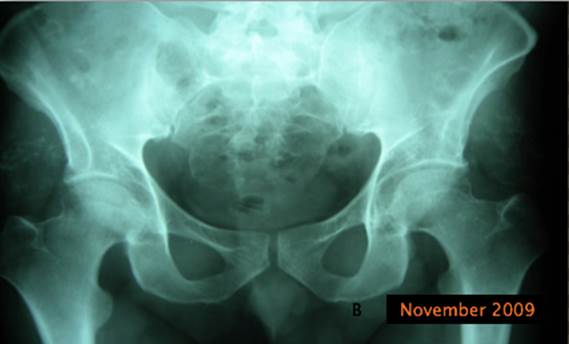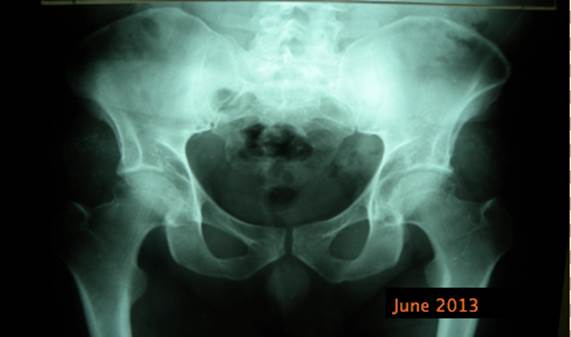Session Information
Session Type: Abstract Submissions (ACR)
Calcinosis cutis is the deposition of insoluble calcium salts in skin or subcutaneous tissue. In cases related to CTD, presents with normal calcium/phosphorus metabolism, and is frequently associated with SSc and DM. Despite therapies available, treatment response is often poor.
Methods:
The subject is a 38-year-old male that presented with classic DM in 2007. Secondary causes were ruled out. He was treated with corticosteroids and methrotrexate, with recovery of muscle strength and normalization of creatinkinase. In May 2008 without DM activity, he presented progressive painful subcutaneous calcifications in the axillary, gluteal and popliteal region, hands and back, confirmed by x-ray. Metabolic studies were normal.
Infliximab was initiated (200mg tid every 8 weeks totaling 5 doses), with poor response and progression of calcinosis.
Results:
In August 2009 therapy with sodium thiosulfate was initiated: 50ml at 25% (12,5gr) in prolonged infusion over 60 minutes qid, with 10 doses per session. He received 17 monthly sessions, with a slow but significant regression of pain and calcinosis. Adverse effects were nausea, headache and infusion site pain, all mild. The patient has remained asymptomatic, without new calcinosis.
Conclusion:
Sodium thiosulfate is a calcium chelating agent, with unknown mechanisms of action, such as the formation of soluble complexes, antioxidant, protector of the endothelium, vasodilator, antithrombotic, anti-metaloproteases and increases endogenous calcification inhibiting proteins. Recent studies show benefit in dialysis-associated calcification. Its systemic use in the treatment of CTD associated calcinosis has been only communicated through case reports. Our patient presented with favorable outcome, with clinically significant reduction of calcifications and reduction of pain without major adverse effects, which might lead to a more effective therapy than available options.
 |
 |
Disclosure:
M. C. Florestano,
None;
M. Álamo,
None.
« Back to 2014 ACR/ARHP Annual Meeting
ACR Meeting Abstracts - https://acrabstracts.org/abstract/successful-therapy-with-intravenous-sodium-thiosulfate-for-adult-dermatomyositis-associated-calcinosis/
